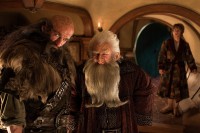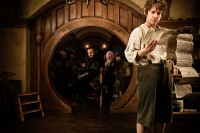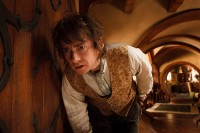 A TALE THAT GREW IN THE TELLING: ADAPTING THE HOBBIT
A TALE THAT GREW IN THE TELLING: ADAPTING THE HOBBIT
“In a hole in the ground there lived a Hobbit. Not a nasty, dirty, wet hole, filled with the ends of worms and an oozy smell, nor yet a dry, bare, sandy hole with nothing in it to sit down on or to eat: it was a Hobbit Hole, and that means comfort.”— The Hobbit, by J.R.R. Tolkien
On September 21, 1937, J.R.R. Tolkien published a children’s book called The Hobbit, or There and Back Again. Since its first publication, the book has sold more than 100 million copies and been translated into some 50 languages. In 75 years, it has never been out of print.
The Hobbit, as it became popularly known, emerged from the imagination of the revered author, poet, university professor and philologist as a bedtime story for his children, but the text is illuminated by the author’s love of nature and fairy tales, his experiences in war, and his sense of kinship with humble souls who prevail against insurmountable odds.
The tale of the Hobbit Bilbo Baggins, who is plucked from his comfortable Hobbit Hole and plunged into a wondrous and dangerous adventure in the company of the Wizard Gandalf the Grey and 13 Dwarves, has been devoured by generations of readers as a literary rite of passage. It at once defined the call to adventure, the nature of honor and loyalty, the yearning for home, and the quiet courage of the unlikeliest of heroes. It also introduced to the world the complex civilizations and magical landscapes of Middle-earth—a deep and richly layered world that Tolkien would spend his life exploring in his writings—which would have a profound cultural impact around the world.
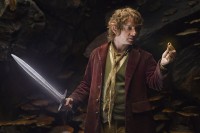 Though the book inspired adaptations in a variety of media, from the stage to comic books to video games, The Hobbit has never been fully realized on the big screen…until now. In the world of contemporary cinema, there is one filmmaker who has proven his passion and dedication for bringing this masterpiece to life—who has famously ventured into Middle-earth before.
Though the book inspired adaptations in a variety of media, from the stage to comic books to video games, The Hobbit has never been fully realized on the big screen…until now. In the world of contemporary cinema, there is one filmmaker who has proven his passion and dedication for bringing this masterpiece to life—who has famously ventured into Middle-earth before.
Over a decade ago, director Peter Jackson embarked on his own quest to adapt the later Tolkien work into the groundbreaking “The Lord of the Rings” Trilogy—three films that have carved their own indelible place in the cultural lexicon. Each was a blockbuster that garnered critical accolades and awards, culminating in the final film, “The Lord of the Rings: The Return of the King,” which won 11 Oscars®, including Best Picture, Best Director and Best Screenplay.
Tolkien had moved on from The Hobbit to write his three-volume opus The Lord of the Rings, but Jackson’s journey went in the opposite direction. Following his experience making “The Lord of the Rings” films, he is now going back in time to tell what was, in fact, the first part of that story, which unfolds 60 years earlier, in a new trilogy, beginning with “The Hobbit: An Unexpected Journey.”
“When we made ‘The Lord of the Rings,’ I was absolutely sure it was going to be a once-in-a-lifetime experience,” Jackson comments. “It was an amazing and very special time, but when it was over, none of us believed that we’d ever be venturing into Middle-earth again. However, the experience of making ‘The Hobbit’ Trilogy became equally special to all of us. So now I have had a once-in-a-lifetime experience twice in a lifetime.”
Though Jackson was involved in the development of the project from the start, only when he dove into the work of crafting the screenplay with his longtime collaborators Fran Walsh and Philippa Boyens, along with Guillermo del Toro, did he decide to direct the films himself. Drawn in by the thematic threads and emotional struggles woven throughout the propulsive narrative, he envisioned films that would mirror the scale, breadth and high stakes of “The Lord of the Rings” films.
“The Hobbit has a breathless pace because Tolkien was writing it as a story for his children and for the children of the world,” Jackson notes. “It’s a ripping yarn that moves from event to event, and really doesn’t stop. It’s a little more humorous than The Lord of the Rings, the characters are a little more colorful, but it nonetheless has elements of greed and madness, of an innocent who is changed forever, and of the gathering forces that will lead directly into the events in The Lord of the Rings. This is where it all starts.”
With “The Hobbit: An Unexpected Journey,” the filmmakers hoped to bring the story to vibrant, visceral life, with all the magic and majesty, humor and darkness, and intimate human emotion that the author himself provided. Screenwriter/producer Fran Walsh notes, “We always saw The Hobbit as a slightly more golden-hued fairy tale. But, by the time you get to the end of the novel, I think you can see how Tolkien puts himself in the place where he would begin that epic journey of writing The Lord of the Rings. That, to us, is our natural transition point into that darker time. The nature of honor and leadership and power—those big themes that are quite prevalent in The Lord of the Rings—were being awakened in The Hobbit.”
To service this transition in crafting the screenplay, Jackson, Walsh and Boyens did not simply adapt The Hobbit as originally published. What many people may not know is that the author himself continued to develop the story further, ultimately publishing extensive notes about the time in which The Hobbit unfolds within 125 pages of appendices that he included at the end of The Lord of the Rings. “The Hobbit was the first time Tolkien let the rest of the world into his incredible mythology, the world of Middle-earth,” says Philippa Boyens, the avowed “Tolkien geek” among the screenwriting team. “There are conflicts, relationships and events that are hinted at but not explicitly described in the book. So when Tolkien sat down to write its sequel and ended up writing The Lord of the Rings, he took time to revisit the events surrounding The Hobbit because he had a very strong sense that within this little children’s book were the seeds of a greater legend.”
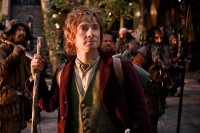 This incredible resource freed the filmmakers to grow the world and tell more of the story in their film. But, at the same time, they saw themselves as shepherds of a work they all loved, and as they wove in some of the darker elements, they took care not to compromise the tone of the book. “The Hobbit was almost a lifetime’s work for Tolkien,” Jackson attests. “And a lot of the ideas he had for fleshing out the story—the environment and the politics of the time—are all there in the appendices of the final volume of The Lord of the Rings. What became clear to us is that the story has the ability to expand yet still be The Hobbit that everybody knows and loves. So that’s what we did, using his notes very much as our blueprint. I found it fascinating that something with a relatively innocent beginning ultimately becomes an epic unto itself.”
This incredible resource freed the filmmakers to grow the world and tell more of the story in their film. But, at the same time, they saw themselves as shepherds of a work they all loved, and as they wove in some of the darker elements, they took care not to compromise the tone of the book. “The Hobbit was almost a lifetime’s work for Tolkien,” Jackson attests. “And a lot of the ideas he had for fleshing out the story—the environment and the politics of the time—are all there in the appendices of the final volume of The Lord of the Rings. What became clear to us is that the story has the ability to expand yet still be The Hobbit that everybody knows and loves. So that’s what we did, using his notes very much as our blueprint. I found it fascinating that something with a relatively innocent beginning ultimately becomes an epic unto itself.”
They also wanted to fully immerse the audience in Middle-earth. For the first time, Jackson utilized state-of-the-art digital cameras to record the action in 3D at an unprecedented 48 frames per second (fps) for release in High Frame Rate 3D (HFR 3D), as well as all the standard formats. “We want ‘The Hobbit’ films to be a visual experience that goes several steps beyond ‘The Lord of the Rings,'” Jackson says. “3D didn’t really exist in mainstream cinema ten years ago at the level it does now, and we’ve shot the movie at 48 fps, which makes it the first feature film to be shot using today’s High Frame Rate technology.”
Jackson once again drew together members of the cast of “The Lord of the Rings,” including Ian McKellen as the Wizard Gandalf the Grey, Cate Blanchett as Elf Queen Galadriel, Hugo Weaving as Elf Lord Elrond, and Andy Serkis once again playing Gollum. Framing the story are Elijah Wood reprising the role of Frodo Baggins, and Ian Holm as Old Bilbo Baggins, who recalls his great adventure prior to leaving Bag End. Leading the international ensemble cast are Martin Freeman as Bilbo Baggins, the Hobbit at the center of the tale, and Richard Armitage as the Dwarf warrior Thorin Oakenshield.
Together, this team of filmmakers and artists embarked on a new adventure—once again shooting three movies back-to-back to create a new motion picture trilogy, one that begins with a Hobbit living in a hole in the ground, on the brink of an incredible, and quite unexpected, journey.
THE UNEXPECTED PARTY: THE STORY AND CHARACTERS
“My dear Frodo, you asked me once if I had told you everything there was to know about my adventures. While I can honestly say I have told you the truth, I may not have told you all of it.” — Bilbo Baggins, “The Hobbit: An Unexpected Journey”
 A WIZARD, A HOBBIT AND A DWARF KING
A WIZARD, A HOBBIT AND A DWARF KING
Sixty years before his nephew Frodo would take his own great and terrible journey, Bilbo Baggins is living a contented, peaceful existence in his cozy home of Bag End in the market town of Hobbiton. Like all of his kind, he loves his home and knows little of the world beyond the Shire, except what he gleans from his precious books and maps.
To play the Hobbit at the center of the adventure, the filmmakers had only one actor in mind: Martin Freeman, who has been praised for the effortless humor and humanity he brings to comedic and dramatic roles alike. “Martin has this amazing gift to be vulnerable at the same time as being staunch and strong,” Boyens describes. “He can be funny at the same time as having pathos. All those qualities told us that he was Bilbo Baggins. We knew that Martin could take you along with him on this extraordinary journey.”
Out of the film’s colorful group of Dwarves and Wizards, Elves and Trolls, Bilbo is possibly the most relatable to audiences. Jackson confirms, “Bilbo is like a regular person, and reacts the way any one of us likely would if we were in his situation. When Bilbo is faced with a Troll, he doesn’t necessarily grab his sword and start fighting—he panics. And that’s what’s so incredible about Martin. He doesn’t want to pretend any of it; he’s always real and authentic. I’ve always thought of Hobbits as being very English, with their little cups of tea and their feet up by the fire. Martin is probably one of the nearest people to a Hobbit that I’ve ever met,” the director adds with a smile.
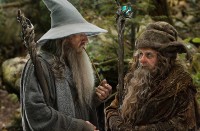 Determined that Freeman was Bilbo, Jackson rearranged the shooting schedule to build in a hiatus for the actor to leave New Zealand and travel to the UK to perform his role as Watson on the television series “Sherlock.” “I was truly shocked and pleased because I really wanted to play Bilbo, and that’s not the kind of offer that comes back,” Freeman recalls. “It showed that they had such faith in me as Bilbo. They must have seen something in me that could play worry, but with humor.”
Determined that Freeman was Bilbo, Jackson rearranged the shooting schedule to build in a hiatus for the actor to leave New Zealand and travel to the UK to perform his role as Watson on the television series “Sherlock.” “I was truly shocked and pleased because I really wanted to play Bilbo, and that’s not the kind of offer that comes back,” Freeman recalls. “It showed that they had such faith in me as Bilbo. They must have seen something in me that could play worry, but with humor.”
Freeman describes Bilbo as “quite self-sufficient. He is also quite self-satisfied, I think, a learned man without having traveled the world. The things that struck me about him suggested a certain timidity in many situations, a certain hesitancy in life, because his world is his home and Hobbiton, and beyond that is a bit scary.”
But Bilbo’s comfortable life is shaken by the arrival of the Wizard Gandalf the Grey, who has ambitious plans for the unsuspecting Hobbit. Once again playing the wise, intuitive, and occasionally mischievous Wizard is Ian McKellen. Among his many acclaimed roles, perhaps the stage and film star’s most iconic has been his embodiment of Gandalf, in all his incarnations, in “The Lord of the Rings” Trilogy.
“Seeing Ian McKellen on set in his costume with his beard and hat, that’s Gandalf,” Jackson says. “It crosses over between movie character and cultural icon in a strange way.”
Though the esteemed actor had trepidation about repeating himself, he ultimately couldn’t resist the prospect of once again donning the robes, beard and hat of Gandalf. “Going back to this character was perhaps not as enticing as taking on a new role, and it was a big commitment, but, in the end, I couldn’t really bear anyone else playing Gandalf,” McKellen says. “And over the years I’ve heard from quite a lot of fans that they’d be upset if I didn’t play him. So, I was thrilled to come back and spend time with this wonderful family again.”
Gandalf has chosen to advise and accompany the Dwarf Lord Thorin Oakenshield on his mission into the Wastelands of the Lonely Mountain to take back Erebor, the lost kingdom and homeland of his tribe, which was long ago attacked and conquered by the Dragon Smaug. “Gandalf seems to like Dwarves, or admire them,” McKellen says. “And because he’s old—6,000 or more years—he can put the current situation into context of recent and past history, and make a judgment that now is the time to help them.”
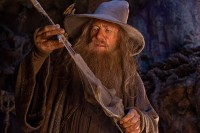 And Gandalf sees Bilbo as a critical piece of the puzzle—to be their secret weapon if and when they reach Erebor. “Gandalf, who is advising the Dwarves on strategy and tactics, thinks they need a burglar,” Jackson explains. “Somebody who could sneak into Erebor right under the Dragon’s nose, and Gandalf likes the idea of a Hobbit because Dragons aren’t aware of their smell. He wants Bilbo to be that burglar.”
And Gandalf sees Bilbo as a critical piece of the puzzle—to be their secret weapon if and when they reach Erebor. “Gandalf, who is advising the Dwarves on strategy and tactics, thinks they need a burglar,” Jackson explains. “Somebody who could sneak into Erebor right under the Dragon’s nose, and Gandalf likes the idea of a Hobbit because Dragons aren’t aware of their smell. He wants Bilbo to be that burglar.”
That’s news to Bilbo, who has never stolen anything in his life. But, having met Bilbo as a child, Gandalf believes he’s the right Hobbit for the job. “I think Gandalf lands on Bilbo because he remembered him as a feisty lad who was up for anything,” McKellen describes. “He discovers, to his surprise, that this bright boy has settled into a life of some complacency. But Gandalf suspects that inside Bilbo, somewhere, there is the right spirit for adventure.”
Before Bilbo knows exactly what’s happening, he finds his tidy little Hobbit Hole filling up with Dwarf after raucous Dwarf. Until at last, their leader appears at the door—the legendary Dwarf warrior Thorin Oakenshield, played by Richard Armitage. Thorin is the direct descendent of the line of Durin, the Dwarf Kings of Middle-earth. He is also King-in-waiting to the throne of Erebor, who witnessed the kingdom’s destruction under Smaug’s terrifying onslaught, losing both his father Thráin and grandfather Thrór in the aftermath.
“Thorin inherited a quest of vengeance from his father, to reclaim what’s theirs and take his people back to Erebor,” Armitage says. “And that burden is quite a lonely thing to carry. Thráin disappeared trying to do the same thing a hundred years ago. So Thorin feels like it’s now or never. I think he’s like a dying ember. He has the potential to reignite into a huge furnace, but if he doesn’t do it now, that ember will die.
“Interestingly,” Armitage adds, “the translation of Thráin is ‘yearner’ and Thorin is ‘darer.’ Thráin is the one that yearned for it, but wouldn’t achieve it. Thorin is the one that would dare to do it.”
“Thorin is an extremely noble and flawed character,” comments Fran Walsh. “His is a tragic story and very moving. He is fighting for his people, who were rendered homeless and wandered without status for so many years. His story is about Erebor and his dream of fulfilling that homeland.”
Handsome, regal, and tall for a Dwarf, Thorin is a brave leader worthy of respect. But, rather than rallying an army around him, he has only managed to raise an eclectic collection of 12 Dwarves. “There is always building within him this paranoia that he’s not a good enough leader, and that weighs him down,” Armitage says. “I have experienced that same feeling as an actor in this role. There were times when I felt like I was on very shaky ground. But what I find fascinating about working with Peter is that he has the whole film in his head, so you know you’re in safe hands. He knows the character better than I do, and the subtle guidance that he gave me just filled me with confidence.”
The gravity of his journey made Thorin’s casting particularly crucial for the filmmakers. “Thorin is the leader of this band of Dwarves, and we needed someone who inherently had that strength and authority,” Jackson comments. “And those qualities are very much reflected in the way Richard completely owns the character of Thorin. He’s the most wonderfully quiet person in real life, and yet when he steps into the boots of Thorin Oakenshield, he totally takes control of that group.”
And what a group it is.
“The Hobbit: An Unexpected Journey” travels with 15 main characters—Bilbo, Gandalf and the Company of Dwarves—which created something of a storytelling challenge for the filmmakers. Jackson explains, “The Dwarves have a huge role to play in the story, so it was important to us that we create distinctive characters with individual styles, and cast strong actors. And what we got was an ensemble of incredibly wonderful personalities to embody the Company of Dwarves.”
The closest to Thorin are the brothers Balin and Dwalin, who are directly related to Thorin in the line of Durin. The gentle-natured, diplomatic and wise Balin, played by Ken Stott, is one of Thorin’s most trusted advisors. And though he is loyal, says Stott, “Balin is somewhat reluctant to be involved in the sense that he doesn’t know whether it’s a noble idea to try to take back Erebor. He believes they should just let it be. And if they’re going to trust their lives to someone, Bilbo is the last one they’d choose. You only have to look at him to see that there’s no way he’s going to get them through this. But, slowly and surely, he wins their respect.”
Both brothers have experienced war, and while it has made Balin more reluctant, his brother Dwalin, played by Graham McTavish, is all in. A powerful warrior—tall, muscular, tattooed and fearless—Dwalin has unshakeable belief in Thorin’s leadership and would defend him to the death. “Dwalin is an absolute, kick-ass warrior,” says McTavish. “He has no illusions about what the quest will be like. It’s practically a suicide mission, and he doesn’t think everyone in the group has quite realized that. Dwalin’s not one for cracking gags and telling tales around the campfire. Oh, no. He’s got his axes out and he’s getting those blades nice and sharp!”
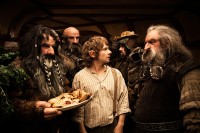 At the opposite end of the spectrum are Thorin’s nephews, Fili and Kili, played by Dean O’Gorman and Aidan Turner, respectively. They are too young to have lived through the great Dwarf battles and don’t quite know what they’re in for. “They’re the exuberant ones,” says O’Gorman. “Fili sees the quest as his birthright, an important part of his life’s journey. And it sounds like a boy’s dream adventure. He starts out with this very youthful enthusiasm, but as the story progresses, the seriousness becomes apparent.”
At the opposite end of the spectrum are Thorin’s nephews, Fili and Kili, played by Dean O’Gorman and Aidan Turner, respectively. They are too young to have lived through the great Dwarf battles and don’t quite know what they’re in for. “They’re the exuberant ones,” says O’Gorman. “Fili sees the quest as his birthright, an important part of his life’s journey. And it sounds like a boy’s dream adventure. He starts out with this very youthful enthusiasm, but as the story progresses, the seriousness becomes apparent.”
Fili and Kili have a rude awakening when they arrive at Bag End and see the Company they’ll be traveling with. Says Turner, “They thought they were going to step into a dream team here, and suddenly, they look across the table and see this rogue’s gallery. There’s a guy with an axe stuck in his head, some heavy drinkers, some pensioners, a thief who’d rob from his own mother, and a Hobbit,” Turner laughs. “But Fili and Kili find it fun and very easy to take the mick out of Bilbo, even in this room of complete misfits!”
Unlike the royal Durin line of Fili and Kili, brothers Bofur and Bombur, and their cousin Bifur, played by James Nesbitt, Stephen Hunter, and William Kircher, respectively, hail from a long line of miners and smithies.
Bofur doesn’t share Balin’s trepidation, Dwalin’s eye of the tiger, or Fili and Kili’s excitement. “Bofur’s overall motive is much simpler than the rest of the Dwarves,” says Nesbitt. “I don’t think he’s necessarily interested in the noble pursuit of reclaiming their lost land. I think he and his kin just fancy a bit of fun, a bit of a scrap. He’s an optimistic Dwarf. He has a pretty good take on life. I think Bofur’s a mixture of the rough, the honest, but also the caring.”
Bifur stands out in the Company because he has the rusty remains of an Orc axe embedded in his forehead. Wild-haired and wild-eyed, Bifur is a fierce and unpredictable fighter who communicates with hand gestures, grunts and the occasional, unexpected exclamation in Khuzdul, an ancient and secret language known only to the Dwarves. Says Kircher, “He has a head injury, so he can only speak in ancient Dwarvish. And, unfortunately, nobody understands him, not even his fellow Dwarves. Only Gandalf, who understands ancient Dwarvish, understands Bifur.”
What Bombur understands is food, so it’s not surprising that his passion and main focus in life is cooking and eating. “Bombur is the biggest Dwarf, though he’s not tall like Thorin or Dwalin,” says Hunter. “Let’s not beat around the bush—he’s the fat Dwarf. He, Bofur and Bifur are pretty rough characters. They’re the scrappers, and they can hold their own in a fight.”
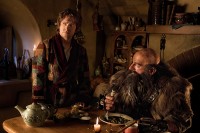 Brothers Oin, played by John Callen, and Gloin, played by Peter Hambleton, are the more senior members of the traveling group. Brave Northern Dwarves and distant cousins of Thorin Oakenshield, they have a profound sense of loyalty to their kin. Oin, the elder of the two, is a healer and something of a seer, whose insights, in fact, set the journey in motion. “Oin recognized that when the birds are flying, when the ravens are returning to Erebor, that perhaps Smaug’s reign of terror is over,” Callen explains.
Brothers Oin, played by John Callen, and Gloin, played by Peter Hambleton, are the more senior members of the traveling group. Brave Northern Dwarves and distant cousins of Thorin Oakenshield, they have a profound sense of loyalty to their kin. Oin, the elder of the two, is a healer and something of a seer, whose insights, in fact, set the journey in motion. “Oin recognized that when the birds are flying, when the ravens are returning to Erebor, that perhaps Smaug’s reign of terror is over,” Callen explains.
Gloin is the “accountant” of the enterprise and keeps a strict eye on expenditure. He is also a loving family man. His wife is an acclaimed beauty with a very fine beard, and his son—still a child at this time—is Gimli, who, 60 years later, will join the ‘Fellowship of the Ring.’ “Fans will see the resemblance,” Hambleton says. “Gloin’s axe is certainly connected to Gimli’s story, for it is handed down from father to son. And, like his son will be, Gloin is very committed to seeing this through.”
The three brothers Dori, Nori and Ori, played by Mark Hadlow, Jed Brophy and Adam Brown, respectively, are distant relatives of Thorin Oakenshield on their mother’s side, but they each have a different father, and very different temperaments.
Dori is the oldest of the three. He’s a bit of a mother hen, his particular concern being to protect his youngest brother, Ori, from the influence of brother Nori, so consequently he’s a little on the bossy side. Hadlow explains, “Dori is always trying to control his brothers all the time. He feels that he’s got to look after the family unit. These Dwarves are all from different clans, so they’re all somewhat skeptical of each other at first. But an incredibly strong bond is built up through the film.”
Nori is certainly not like either of his brothers. He left home at a young age and lived on his quick wits and ingenuity for years before returning to the fold. Any attractive or useful item that’s not nailed down is likely to fall prey to his light fingers. “He’s a bit shifty, a bit of a back-stabber, a bit of a thief,” Brophy describes. “Lovely guy, but probably not someone you’d want to marry your Dwarven daughter.”
Ori is the opposite of his brother. Sweet natured and endearingly innocent, he writes and draws to record the quest. “I think that Ori is quite an unlikely Dwarf,” says Brown, making his big screen debut. “He’s the young, naïve one, the youngest of the group. But he does want to prove himself, not just to his brothers, who try to mother him all the time, but also to Thorin. He wants to be part of the legend.”
On this long journey with the Dwarves, Bilbo begins to relate to their bone-deep need to return to their homeland of Erebor. “Throughout his adventure, Bilbo keeps with him his memories of Bag End, where he belongs,” Boyens explains. “He longs to be back there, and those thoughts of home are a huge source of strength for him. And, through that connection to his own home, he begins to understand what has been taken from these Dwarves—that sense of belonging somewhere. And that, more than anything else, helps him understand who these Dwarves are.”
Though they have varying accents and personal styles, the Dwarves are quite an experience. “You could liken the Dwarves to a group of steelworkers and miners who work very hard and have nobility and a great work ethic, and yet, they like to sit down at the pub and down a few pints of ale as much as anybody,” Jackson describes. “They also have a sense of humor and are great fighters. There’s a raucous quality to them. They’re as good at letting off steam as they are at fighting Orcs in battle.”
After the Dwarves invade Bilbo’s home, emptying his pantry for a feast and closing the meal with a massive food fight, Bilbo begins to grasp what Gandalf and Thorin want of him—to join them on a long and dangerous journey with a deadly Dragon waiting at the end of it. “Bilbo is not a warrior,” says Freeman. “He’s not adept with a sword and he’s never been on a horse, which you can tell quite clearly from the way he holds the reins. Yet Gandalf wants him to leave Hobbiton with this band of rogues, an idea which is a bit mad. Bilbo has got his routine and he likes it, and they’re asking him to put himself knowingly in danger, with the threat of physical harm, from which he may not return. So, the question becomes, why does he go then? He goes because he knows that he will never have another opportunity like this.”
Gandalf has produced a key and an ancient map that may reveal a secret entrance into the Lonely Mountain, where the underground kingdom of Erebor waits. But the Company of Dwarves needs one more specialist in order to complete their task. The map is encrypted, and Gandalf knows of only one being with the ability to decipher it.
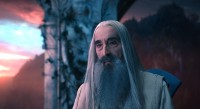 THE WHITE COUNCIL AND THE DARKENING OF GREENWOOD
THE WHITE COUNCIL AND THE DARKENING OF GREENWOOD
Leaving the Shire on the backs of ponies, the Company sets down in Trollshaw Forest for a rest, but are soon ambushed and nearly roasted alive by three hulking, hungry Trolls—William, Bert and Tom—last seen as statues in “The Lord of the Rings.” “This is the first time that Bilbo experiences absolute, terrifying danger on this journey, and he’s put to the test,” Jackson says. “It very much defines Bilbo’s ongoing role in terms of his relationship with the Dwarves.”
Not long after, they encounter an old colleague of Gandalf’s, the Wizard Radagast the Brown, played by stage actor and one-time Doctor Who, Sylvester McCoy.
Eccentric, a little forgetful and easily distracted, Radagast is one of the Istari, or Wizards of Middle-earth, a group of five that also includes Gandalf the Grey and Saruman the White. But, unlike the others, Radagast long ago withdrew from society to live quietly in the Southwestern fringes of Greenwood in his tumbledown house, Rhosgobel. Radagast’s friends are the wild animals and birds of the forest, and he moves about in a sleigh pulled by large rabbits. McCoy sees the character as emblematic of the known concerns Tolkien had for the preservation of the Earth. “I think Radagast is similar to St. Francis of Assisi in many ways,” McCoy offers.
Boyens offers, “Radagast is not so interested in the affairs of the people of Middle-earth, Elves or Dwarves or Hobbits. He’s much more concerned with the welfare of the animals, the trees, and the natural world. And, because of his connection, he is the first to discover a growing evil within Greenwood, which is coming to be known as Mirkwood. He comes to believe that after years of peace and prosperity through Middle-earth, an ancient horror may have returned to the world.”
“Middle-earth is starting to rumble and tumble a bit,” says McKellen. “Things seem to be changing and not for the better. There are forces at work, and Gandalf is looking to uncover just what those forces are. That leads him to Radagast, who is the first to see the signs. But it takes Gandalf’s intelligence and sense of the larger picture to make the connections.”
Radagast’s trust provides a key link for Gandalf as he begins to unravel a mystery involving the ancient abandoned fortress of Dol Guldur. “That was a part of the story that Tolkien alluded to, but didn’t write,” Walsh notes. “We’ve always wanted to fold in Gandalf’s story at Dol Guldur, and I know a lot of the fans are very keen to see that part of the story told.”
The possible presence of a dark Sorcerer—the Necromancer—at Dol Guldur gives Gandalf’s part of the quest a greater sense of urgency. Another development is the presence of a swarm of misshapen, monstrous Orcs tracking the Company on the backs of deadly wolf-like Wargs. After fending off an ambush by these fierce and powerful creatures, the Company finds its way to the Elven outpost of Rivendell, a majestic oasis hidden within a deep river valley, where they are not exactly welcomed.
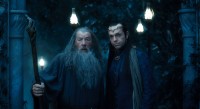 This feeling is mutual. “It goes way back to Erebor,” Armitage explains. “The Elves coveted what the Dwarves had. And when the Dragon attacked, the Elves did nothing. They let the Dwarves burn, which Thorin will never forget.”
This feeling is mutual. “It goes way back to Erebor,” Armitage explains. “The Elves coveted what the Dwarves had. And when the Dragon attacked, the Elves did nothing. They let the Dwarves burn, which Thorin will never forget.”
The Dwarves are ultimately welcomed on the order of Elrond, once again played by Hugo Weaving, who embodied the Elf Lord in “The Lord of the Rings” Trilogy. But Elrond is skeptical of the wisdom of Thorin’s quest and the part Gandalf plays in it. “I think there’s a great deal of respect between Elrond and Gandalf,” Weaving says. “But Gandalf is doing something Elrond doesn’t approve of by protecting Thorin and the Dwarves. Elrond feels that if they go to the Lonely Mountain and awaken Smaug, that will just stir things up. But there is Gandalf’s other agenda too, and that’s a whole other problem to contend with.”
Gandalf has an ulterior motive for this visit to Rivendell: he wants to bring his suspicions about Dol Guldur to the White Council, comprised of Gandalf himself, Saruman, and the High Elves Elrond, and Galadriel, once again played by Cate Blanchett. “The White Council is referenced in the notes Tolkien created as part of the expanded Middle-earth universe,” says Jackson. “They are really the guardians of Middle-earth, there to keep watch for any sense of danger. This, for us, was a goldmine of material because it allowed us to bring into the films characters we’d already introduced, and to tell the fascinating narrative of this presence at Dol Guldur.”
The White Council, says Weaving, “is essentially working towards a peaceful world and is mindful of the fact that there are forces around them which could, at any time, reignite and threaten their way of life.”
For Weaving, returning to the role also meant having the opportunity to work with old friends. “It’s been really lovely to come back and see people throughout the cast and crew whom we haven’t seen for so many years.”
“So many people who were part of the first journey are part of this journey,” adds Blanchett, who once again embodies the beautiful and wise White Lady of Lothlorien. “I had no expectation there would be anything more after ‘The Lord of the Rings’ Trilogy, and my time there was all too brief. So when I heard that Peter, Fran and Philippa were going to embark on ‘The Hobbit’ films, I became a stalker. I didn’t know if Galadriel was going to be in it, but I was hoping against hope. And then, when I got word that, in fact, she was, I was over the moon.”
Galadriel is a powerful member of the White Council and a vital ally to Gandalf. Blanchett calls her “just a tiny piece of the puzzle. I would hazard a guess that our part of the story—the fact that Gandalf and Galadriel sense that something’s wrong—will have particular resonance and prescience of what is to come. The White Council just doesn’t see it. And what is noble and heroic about Gandalf and Galadriel is that they are prepared, together, to look the future in the eye. That’s what makes Gandalf the most wonderful hero—the courage, against popular opinion, to move into the darkness that no one else is prepared to go into.”
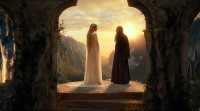 Both Blanchett and McKellen relished working together again and bringing to life the extraordinary bond between their characters. “There’s an emotional connection between them, which I think comes as much from the actors as it does the script,” McKellen says with a smile. “It’s based on their mutual trust and admiration for each other. In fact, I wouldn’t think love was too strong a word, really. They have a sublime intimacy between them.”
Both Blanchett and McKellen relished working together again and bringing to life the extraordinary bond between their characters. “There’s an emotional connection between them, which I think comes as much from the actors as it does the script,” McKellen says with a smile. “It’s based on their mutual trust and admiration for each other. In fact, I wouldn’t think love was too strong a word, really. They have a sublime intimacy between them.”
“It’s not difficult to love Ian. And, as for the characters, perhaps in another life,” Blanchett laughs.
The final member of the White Council is Saruman the White, its leader and the most powerful and revered of the Istari, played by legendary actor Christopher Lee, who also reprises his role from “The Lord of the Rings” Trilogy. “This story takes place 60 years before ‘The Lord of the Rings,’ so I’m playing the original Saruman the White, the noble, the decent, the master of the Wizards, who has not yet turned into the dangerous character that he is to become,” Lee says.
Lee, a lifelong fan of Tolkien—who famously met the author once at an Oxford pub—was thrilled to return to Peter Jackson’s incarnation of Middle-earth. “It’s like being in a time machine,” he says. “It’s extraordinary. And instead of going forward in time, we’re going backward.”
Like Elrond, Saruman sees the Dwarves’ quest as a threat to the peace that has reigned for so long, and he is blind to Gandalf’s warnings about the signs of a gathering darkness. “Saruman thinks Gandalf should know better,” says Lee. “He doesn’t condone this quest at all, this business of the Dwarves. If they’d come to Saruman, he would have saved them disappointment.”
But Gandalf’s choice to help the Dwarves against such steep and perhaps catastrophic odds touches on one of the underlying themes threaded throughout the story. Boyens notes, “Galadriel asks a question of Gandalf, and his answer speaks to something we believe was important to Tolkien and which we very much felt was at the core of our film, which is the goodness of everyday folk, and how the simplicity of a good deed, a simple act of kindness, is as potent and powerful as the greatest act of heroism.”
 GOBLINS, GOLLUM AND A SIMPLE GOLD RING
GOBLINS, GOLLUM AND A SIMPLE GOLD RING
Leaving Gandalf behind, Thorin steals away from Rivendell with Bilbo and his Dwarf companions. Their destination lies to the East, but first they must cross the treacherous Misty Mountains, a tricky proposition that sees them struggling to survive a harsh storm, with the walls of the mountain literally coming to life in a clash of massive Stone Giants. There are equal hazards waiting for them under the mountain, when they fall into a trap set for them by the Goblin horde.
Deep in the Goblin tunnels, Thorin and his men must face off against this vicious, misshapen race of scavengers and killers, led by the hulking Goblin King, played by Barry Humphries, best known for his comedic alter ego Dame Edna. “I play the King of the Goblins, who is one of the most unpleasant characters I have ever inhabited,” Humphries says. “He’s delusional, brutal, totally lacking in empathy, and, above all, hideous. He has an obedient group of Goblins, who are very frightened of him because he’s very cruel. But the Dwarves are his foes. He’s very fond of Dwarves as culinary experiments.”
Bilbo, meanwhile, faces a very different kind of creature when he becomes separated from the Dwarves and tumbles well below the tunnels, to the shores of an undergound lake—the domain of a strange, emaciated creature that seems to survive on fish and Goblins…Gollum, who holds and covets a ring with enchanting and surprising power.
“It was fun for all of us to be able to write once more for Gollum, who is one of our favorite characters,” says Boyens. “He’s not quite the same Gollum we meet in ‘The Lord of the Rings’ films. He’s younger, has a few more teeth, and is a little bit braver in this film. Because he has spent so long—nearly 540 years—down there in the dark preying on hapless Goblins, he has forgotten that he’s vulnerable. His flaw is that he thinks the ring, his ‘precious,’ makes him invulnerable. He doesn’t realize what will happen should he lose it.”
While searching around Bilbo’s cave, the Hobbit stumbles upon the ring and slips the trinket into his pocket. Little does he know its importance to Gollum—and to the future of Middle-earth.
Once again bringing Gollum to life is Andy Serkis, who—with his original incarnation in “The Lord of the Rings,” along with his embodiments of King Kong and Caesar from “Rise of the Planet of the Apes”—has come to define the art of motion capture performance. Serkis’s characterization of the obsessive, dualistic one-time Hobbit has carved its own unique niche in cinema culture.
With so much time passing between then and now, rediscovering Gollum was a process for the actor. “When I played him a decade or more ago, I really got under the skin of the character in a very deep way,” Serkis offers. “So I had no fear that I would not be able to plumb those depths again. But there were a couple of moments early on when I felt like I was doing a pale imitation. And then, when we were actually on the set doing this iconic scene between Gollum and Bilbo, I felt I had truly found my way back to him. I could absolutely feel the reality of Gollum’s situation, the tragedy and the great loss of the one thing he holds dear.”
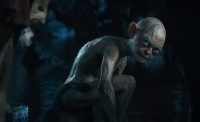 Gollum is prepared to make a meal of Bilbo, but the Hobbit desperately attempts to secure his life and freedom through a game of riddles. “Gollum engages with this being, whom he’s wary of but thinks he can dominate,” Serkis explains. “Part of him is enjoying the game, but there comes a point where the riddles backfire on him. This seminal encounter will lead Gollum to the one thing he will spend the rest of his life pursuing.”
Gollum is prepared to make a meal of Bilbo, but the Hobbit desperately attempts to secure his life and freedom through a game of riddles. “Gollum engages with this being, whom he’s wary of but thinks he can dominate,” Serkis explains. “Part of him is enjoying the game, but there comes a point where the riddles backfire on him. This seminal encounter will lead Gollum to the one thing he will spend the rest of his life pursuing.”
This critical sequence that takes place late in the film was the first one to be shot when production commenced, which turned out to be something of a gift for Freeman. “It’s so well written and was so fun to play, and, obviously, I’m playing opposite Andy,” he relates. “He’s so good and Gollum is so beloved. It’s incredible just to hear him make that voice—something you’re so familiar with, but now it’s real; it’s right in front of you. Peter shot our scene continuously without any breaks, so in some ways, it felt like we were in a nine-minute play. And the week we spent filming this little sequence really helped me find Bilbo.”
The encounter with Gollum has a profound effect on the Hobbit. Though he knows he will never be anyone’s idea of a great hero, “over the course of going on this journey, he finds courage that no one saw in him, really. He didn’t even see it in himself,” Freeman reflects. “We don’t ever know how we’re going to react to something under duress, but he finds resources within himself of loyalty, compassion and ingenuity that he never suspected were there. He has also got some magic about him now. And he’s got the ring, which provides its own magic.”
All images © 2012 Warner Bros. Entertainment Inc. All Rights Reserved.
- Middle Earth Madness & The World Premiere of The Hobbit
- LEGO Lord of the Rings Video Game Review
- LEGO Lord of the Rings Video Game
- The Hobbit: An Unexpected Journey in Theaters Friday
- The Hobbit: An Unexpected Journey – Adapting the Book for Film
- The Hobbit: An Unexpected Journey – Making the Film
- The Hobbit: An Unexpected Journey Original Motion Picture Soundtrack
- The Hobbit: An Unexpected Journey – The Cast

